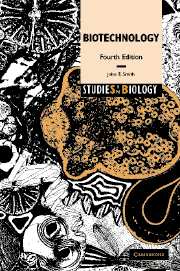Book contents
- Frontmatter
- Contents
- Preface
- 1 The nature of biotechnology
- 2 Substrates for biotechnology
- 3 Genetics and biotechnology
- 4 Bioprocess/fermentation technology
- 5 Enzyme technology
- 6 Biological fuel generation
- 7 Single cell protein (SCP)
- 8 Biotechnology and medicine
- 9 Environmental biotechnology
- 10 Biotechnology in the agricultural and forestry industries
- 11 Food and beverage biotechnology
- 12 Protection of biotechnological inventions
- 13 Safety in biotechnology
- 14 Public perception of biotechnology: genetic engineering – safety, social, moral and ethical considerations
- 15 Looking to the future
- Glossary
- Further reading
- Index
8 - Biotechnology and medicine
Published online by Cambridge University Press: 05 June 2012
- Frontmatter
- Contents
- Preface
- 1 The nature of biotechnology
- 2 Substrates for biotechnology
- 3 Genetics and biotechnology
- 4 Bioprocess/fermentation technology
- 5 Enzyme technology
- 6 Biological fuel generation
- 7 Single cell protein (SCP)
- 8 Biotechnology and medicine
- 9 Environmental biotechnology
- 10 Biotechnology in the agricultural and forestry industries
- 11 Food and beverage biotechnology
- 12 Protection of biotechnological inventions
- 13 Safety in biotechnology
- 14 Public perception of biotechnology: genetic engineering – safety, social, moral and ethical considerations
- 15 Looking to the future
- Glossary
- Further reading
- Index
Summary
Introduction
During the twentieth century there have been the greatest gains in health in most parts of the world owing to dramatic reductions in infant mortality, eradication of life-threatening diseases such as smallpox, and considerable improvements in life expectancy in developing and industrialised countries. In the past, life for most people was coarse, lacking in adequate nutrition, with poor housing and, above all, short in years. With the advent of improved sanitation and better living conditions, together with the availability of vaccinations and antibiotics, there has been, for many, a vast improvement in health status. However, health status still differs widely among nations and by geographic region. For instance, life expectancy is less than 50 years in some sub-Saharan African countries, but over 75 years in established industrialised countries. The wealthiest economies appear to be the healthiest. A crucial factor related to life expectancy is access to safe water! In much of the developing world, simply drinking water is a high-risk exposure.
Undoubtedly, the real gains in health over the last century can be attributed mainly to the impact of public health and disease prevention rather than to medical interventions. Public health can be primarily distinguished from clinical medicine by placing emphasis on the prevention of disease rather than the curing, and having a main focus on population and communities rather than on the individual patient.
- Type
- Chapter
- Information
- Biotechnology , pp. 136 - 155Publisher: Cambridge University PressPrint publication year: 2004



